On our recent family trip to Japan, one of the biggest revelations was the abundance of culinary options everywhere. While there are several izakayas, restaurants, and eateries, street food in Japan offers a variety of pocket-friendly options you can savor, ideal if on a budget holiday.
One important thing to remember about Japanese street food is that the locals don’t like walking and eating. They believe in showing respect for food; thus, one must eat it properly.
So, you can sit on a bench and eat your snacks. Or else, it is customary to stand near/around the street food stand you took the snack from and finish it there.
Here are 34 must-eat street foods in Japan to whet your appetite. Although, this is just the tip of the iceberg, as you can easily add plenty more delicacies to this list. I hope to do that over time.
Takoyaki
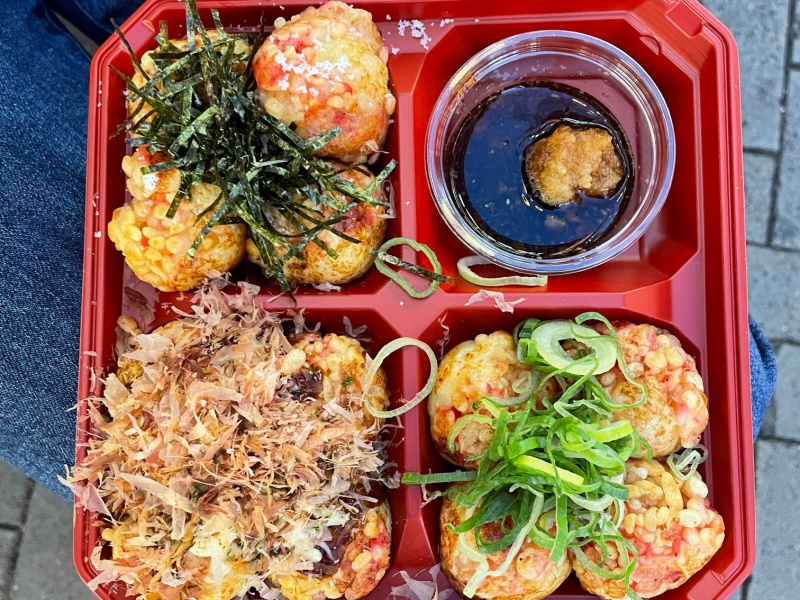
Takoyaki is Osaka’s signature contribution to Japanese mainstream street food culture. It originated in 1935 when a local vendor tried experimenting with a similar food item, Akashiyaki (octopus-filled balls cooked in hot broth).
The savory snack is like a chewy dough ball, deep-fried for a crispy outer texture. The batter includes wheat flour, eggs, and dashi stock.
However, the highlight of this Japanese street food is tempura scraps and diced octopus pieces. In some places, they put an entire baby octopus in the ball.
Takoyaki’s preparation tool is an oil-brushed griddle with small hemispherical molds. Once done, the dish tastes best with sweet and tangy Takoyaki sauce along with toppings like fish (bonito) flakes, nori, pickled ginger, or green onions.
Dango
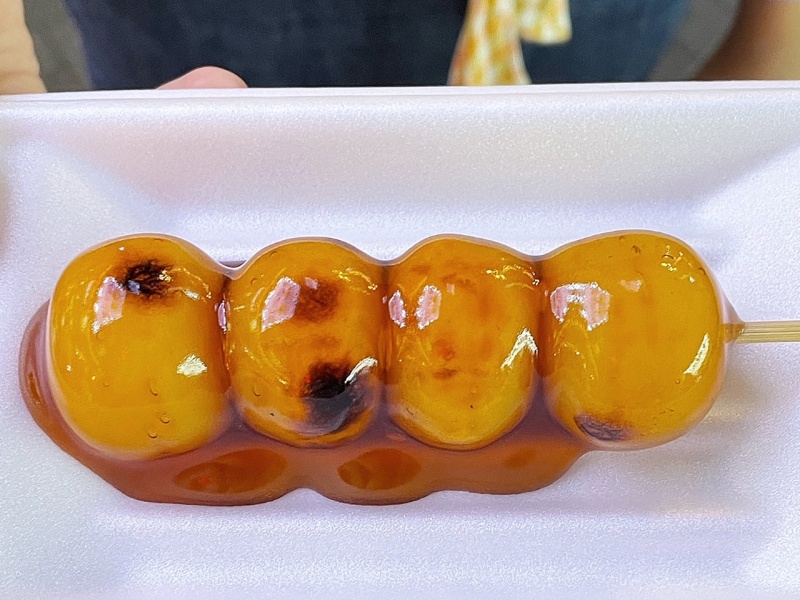
Dango is a form of dense and sticky rice dumpling. The dough contains rice flour mixed with water, modeled into small balls. Dango can be cooked in hot water or grilled on an open flame.
Depending on regions and seasons, various types of flavored Dango are available. The most eminent version, Mitarashi Dango, originated in Kyoto and has a sweet soy sauce coating. Hanami Dango is popular during spring and depicts cherry blossom trees with green, pink, and white dumplings.
Dango’s history dates back to the 12th century, thus making the snack a quintessential cultural symbol and must-eat Japanese street food. Traditionally, these rice dumplings are also essential to Japanese tea ceremonies.
Rikuro’s Cheesecake
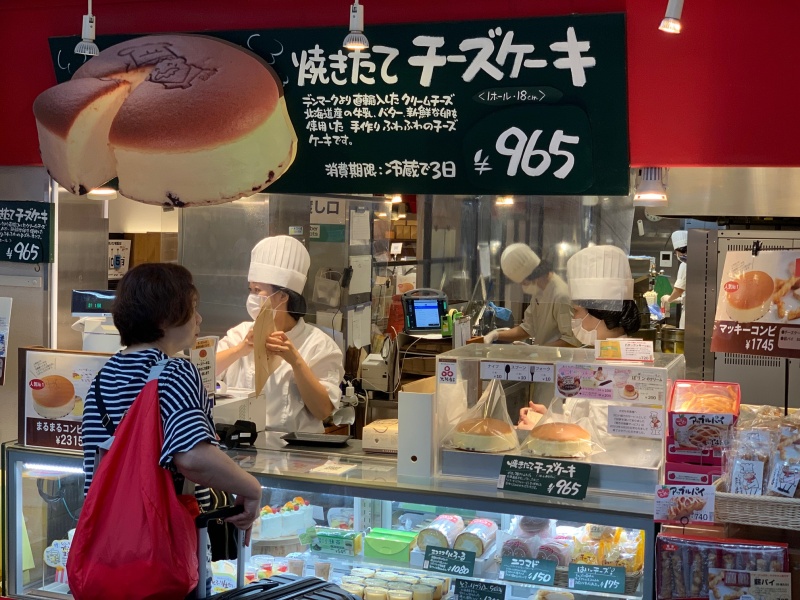
There are several outlets of Rikuro’s famous cheesecake throughout the country. However, the shop in Dotonbori is pretty popular. It’s a mere 2-minute walk from the Namba station. But be prepared to stand in line for another 5 to 15 minutes, no matter the time of the day.
At the time of ordering, the staff usually asks if you want a fresh one or an already made one. Depending on your choice, you might end up waiting a little longer. We were lucky enough to have arrived early in the day, which meant that we got a fresh cheesecake within a few minutes of our arrival.
This fluffy and super-light cheesecake is famous for its wobbling texture. The wobble has made it go viral on social media, but that is not the only reason it is a must-eat street food in Japan.
Rikuro’s cheesecake, which costs just short of Yen 1000, seems quite large initially but has a melts-in-your-mouth quality. While the main cheesecake is somewhat savory, raisins at the bottom add sweetness to every bite. As a family of 4, we finished it in 10 minutes, sitting under the Umeda Sky Building.
Japanese Corn Dogs
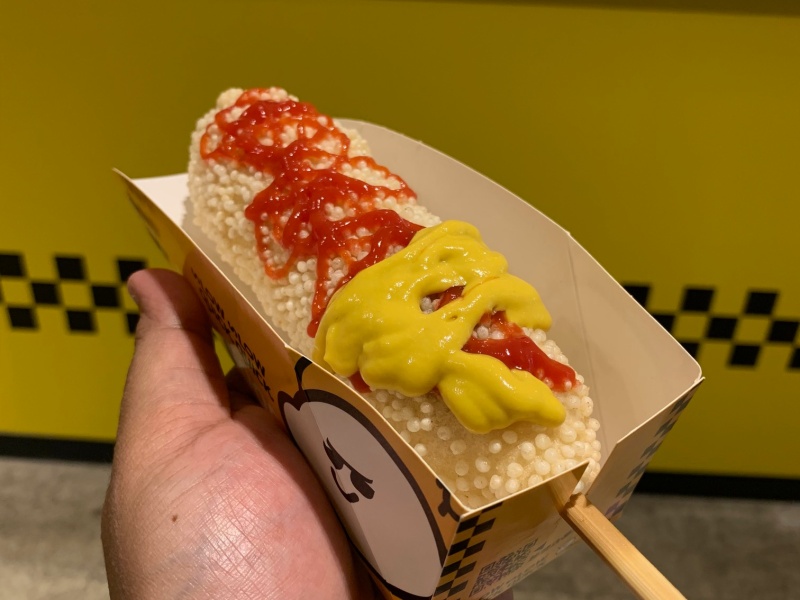
Although I’m sure they exist elsewhere, we came across Japanese corn dogs only in Harajuku, Tokyo, on the penultimate day of our Japan holiday.
Undoubtedly, a comfort deep-fried Japanese street food, the locals have a few different ways they prepare the snack. For vegetarians, you can get ones with only potatoes with or without gooey cheese filling. Otherwise, there’s the classic one with a sausage with or without cheese.
Expect the exterior of the corn dog to have the perfect crunch with a soft inside. If you are opting for cheese, expect it to be delightfully stringy.
Candy Floss
Candy floss is another popular street food in Japan. We came across a few stands in Osaka, but the ones in Harajuku were next level.
We saw multiple people carrying humongous rainbow cotton candy, and we knew we had to get one too. After all, Harajuku is such a colorful place, so why not add to it?
Heading over to Totti Candy Factory, we got their biggest one – a candy floss the size of your face with five different layers. Each layer was a different color and hence, a distinct flavor.
It tasted as incredible as any sweet confection would. Not surpassingly, the four of us finished it within minutes.
Tamagoyaki
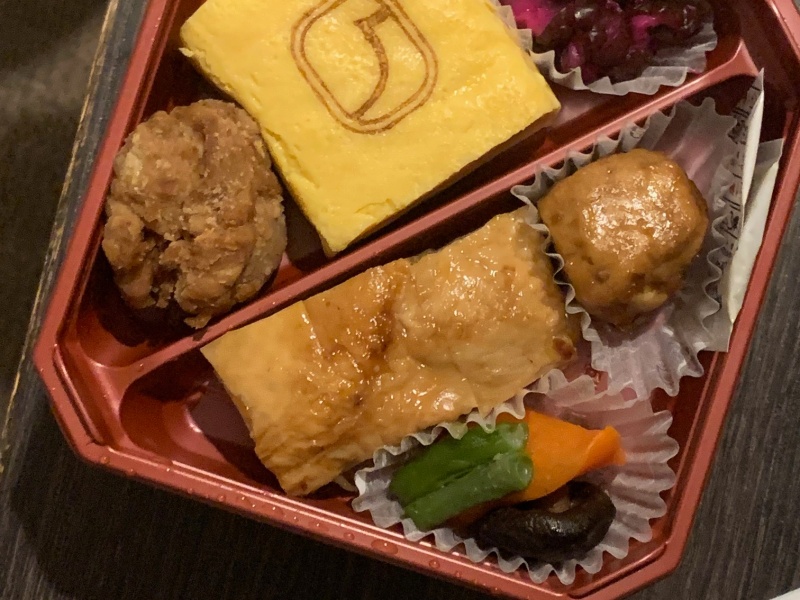
The delectably creamy and layered Japanese omelet is quite a versatile dish. Its soft, melt-in-your-mouth composition further makes it a delight to eat.
Besides being a breakfast staple, you’ll find packed tamagoyaki in convenience stores, salads, and bento boxes.
Moreover, many street food stalls in Japan make fresh omelets and serve them on a stick as tasty street food.
Fancy Crepes
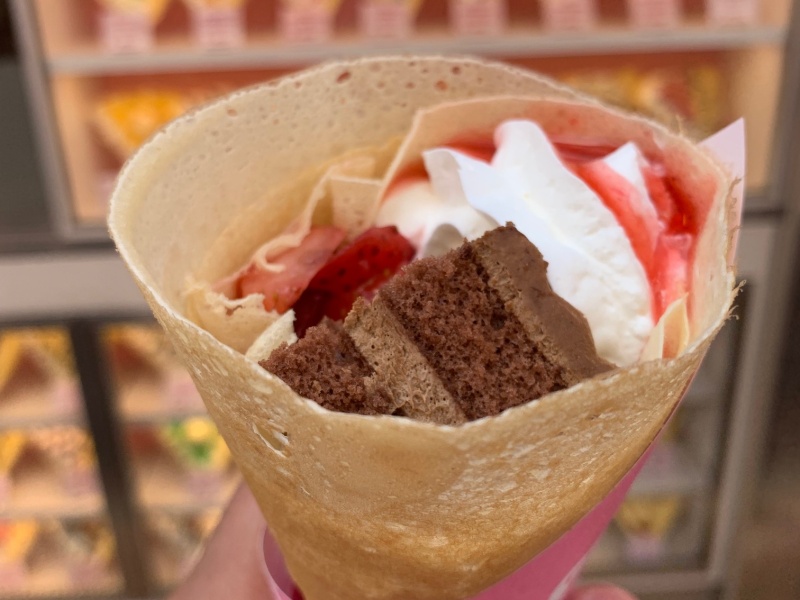
Walking toward Takeshita Street in Harajuku, we came across an entire wall of Sweet Box packed with different crepe options greeted us. I’ve never seen so many sweet and savory crepe variations in my life. Plus, this was not the only crepe shop on the street, as we discovered more while exploring the area.
As with most foods in Japan, the crepes are pretty large in size. Once you’ve decided between sweet or savory, plan on spending another five minutes deciding on flavors.
Crepe choices expand from custard banana chocolate and cream, strawberry and cream, cheesecake, and ham cheese salad to gelato kiwi fruit strawberry, potatoes gratin, tuna salad, and pizza tuna.
Sweet Box is generous with the filling, preparing the crepe just right so it is soft but has a slight crunch. Other crepe shops in Harajuku are Angel’s Heart, Marion Crepes, and Santa Monica Crepes.
Kobe Beef
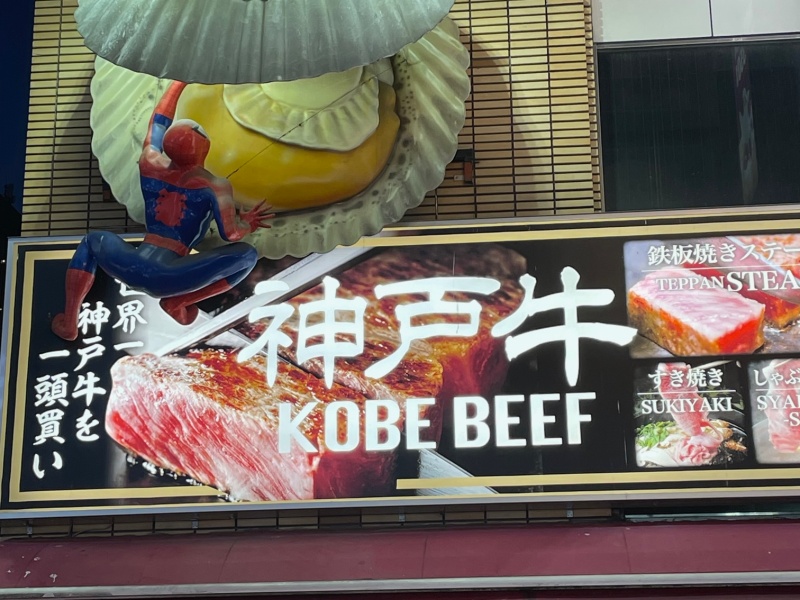
To relish the best Kobe Beef in Japan, you must head to Kobe. But heading to Kobe takes a backseat for many travelers on their first or second Japanese holidays. Thankfully, Kobe Beef is easy to find elsewhere.
A point to note is that Kobe Beef is one of the more expensive Japanese street foods. You can have grilled beef from stands outside restaurants to save some money. However, a Kobe Beef steak is quintessential for carnivores visiting the country.
Gyoza
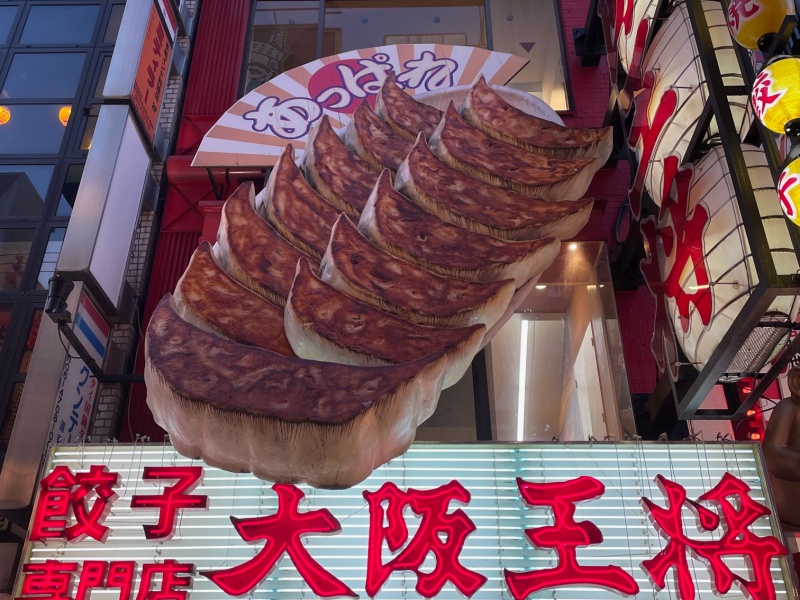
Finding street food in Osaka’s Dotonbori is very simple. Most places have large banners and billboards featuring their specialty (octopus, crabs, beef, dumplings), making them stand out.
Gyoza is Japan’s most loved dumpling and a fun snack to have on the street. Fillings include minced pork, garlic, cabbage, other vegetables, and meats. Soy sauce is the main condiment to dip your Gyoza in before taking a bite.
Depending on your preference, you can order either steamed or pan-fried Gyoza. I prefer the latter for its slightly crunchy skin.
King Crab
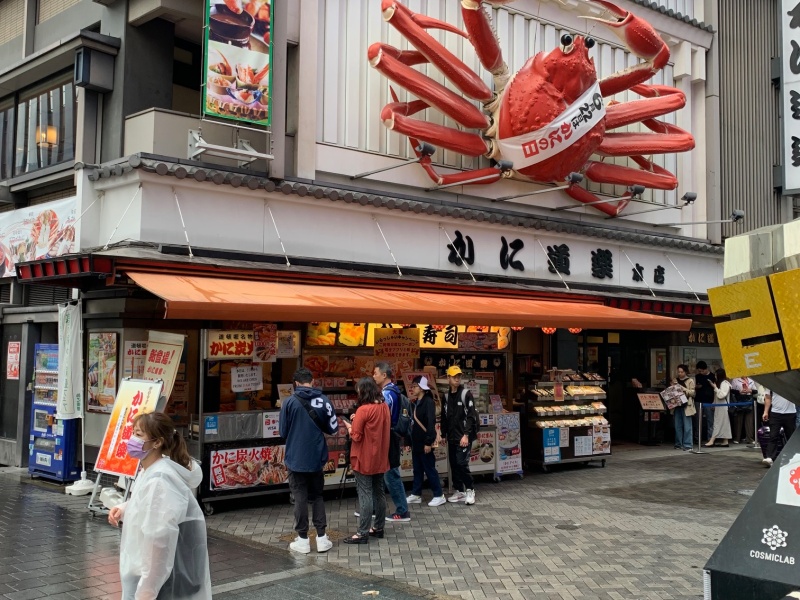
Speaking of billboards, one of the most iconic is the king crab with the moving claws of Kani Doraku in Dotonbori, Osaka. The seafood chain has outlets nationwide, but their first was the one in Osaka. Japan is heaven for seafood lovers, and one of the best street foods to try is freshly grilled crab legs at this eatery.
I love crab meat, mainly because it’s juicy and has a slight sweetness to it. The restaurant has a few crab-based street eats, but for a proper crab-fest, make a booking and enjoy a proper sit-down meal inside.
Fugu
Pufferfish is one of the most adventurous street foods in Japan. Due to certain parts of the fish being poisonous, it’s quite the novelty.
Japanese eat Fugu as sashimi, grilled, or as part of hot pots. It is supposed to have quite an acquired taste.
We did come across a few places selling Fugu. However, being a little unsure about how it might react with my body in general, I decided to give it a miss. I do regret that now.
Rice Crackers
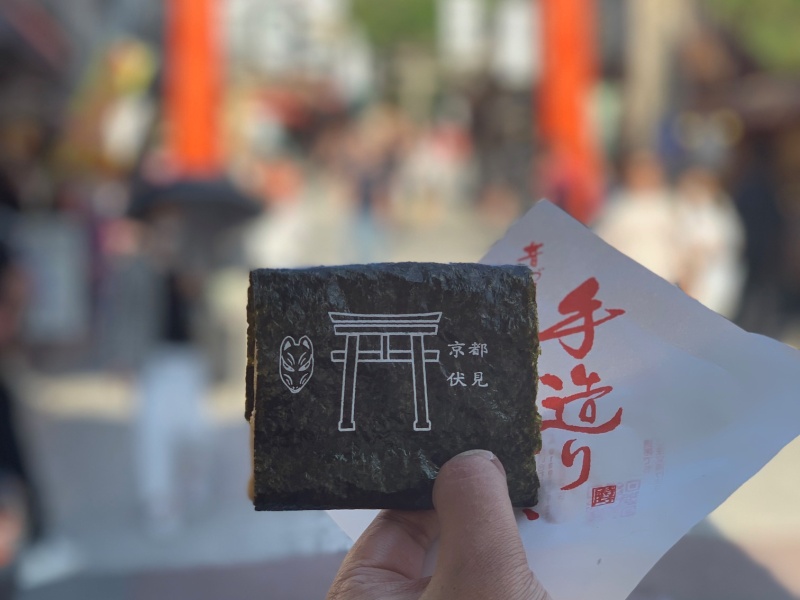
Rice crackers are another snack in Japan you’ll find everywhere. Many street side stalls sell different flavored crackers, while you can also get packed versions in convenience stores.
I picked up a “special edition” rice cracker outside the Fushimi Inari Shrine in Kyoto that came with an imprint of the shrine on the nori.
The cracker was a little hard, and I should have paired it with something, but it did make a good prop for a photograph.
Ice Cream
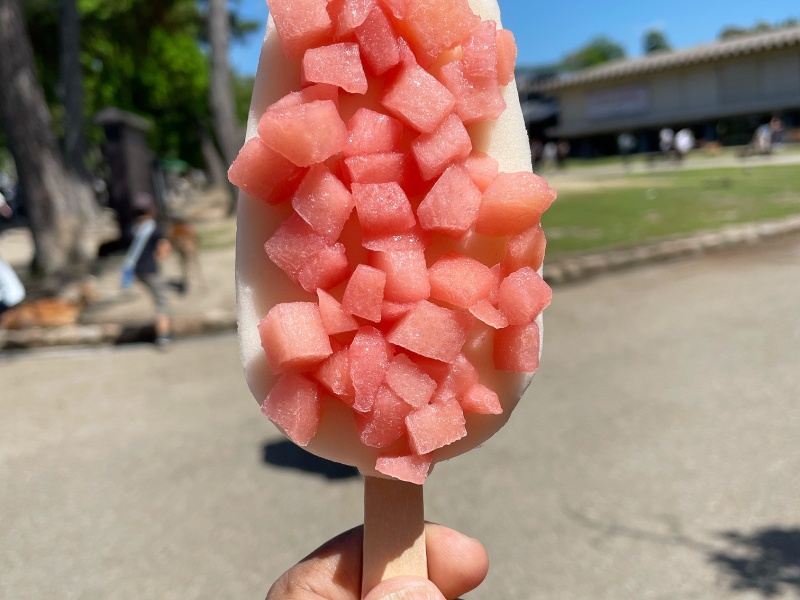
Japanese love ice cream, and that’s evident from the numerous ice cream shops you will come across anywhere and everywhere. Of course, the ice cream has a Japanese touch, whether in the away stalls present it or the various flavors.
Since we walked nearly 20,000 steps daily, there was no guilt regarding over-indulging in ice cream. Among our favorites were the frozen ice cream with real fruit bits in Nara, the über-creamy chocolate and vanilla soft serve in Dotonbori, and the easy-to-eat packed cup ice creams available in convenience stores.
Bento Boxes
Bento boxes epitomize street food in Japan. You’ll find bento boxes at restaurants and outlets in train stations, making them a great food option when taking the Shinkansen (bullet train).
Bento boxes are incredibly diverse in their price range and composition. A bento box in Japan can include everything from cutlets and curry to rice, sushi, sausages, and tamagoyaki.
Besides the normal-looking bento boxes, you can also find special ones shaped like an anime character or train. We were lucky to find the latter towards the end of our holiday.
Moreover, there are apparently self-heating bento boxes, wherein you pull a string, and the box heats its contents. Unfortunately, we did not come across them.
Okonomiyaki
Imagine having a pancake-like base with pizza-like toppings, and you will get Okonomiyaki. The dish’s name translates to as-per-your-liking, offering a selection of different types of condiments like seafood, pork belly, cheese, noodles, squid, crispy bacon, and cabbage.
To cook Okonomiyaki, batter made with flour and eggs goes on a flat grill known as ‘teppan.’ After adding sauces and herbs, it is fluffy and moist to bite into, while the veggies add the right amount of crunch.
Okonomiyaki is majorly popular in Kansai and Hiroshima. The former region cooks the dish by mixing all the ingredients in the batter, while the latter layers them individually.
Okonomiyaki was officially the first street food in Japan we enjoyed during our family trip. Since many places in Dontonbori, Osaka, have seating areas inside, we decided to have a more relaxed meal.
The table at the restraint primarily consisted of a hot teppan where the chefs placed the noodles and Okonomiyaki (so they stay hot for longer). In some places, the chef even comes to the table and cooks the Okonomiyaki on the spot.
10 Yen Cheese Coin
If you go about researching street food in Japan on social media, you are bound to come across the 10 Yen Cheese Coin at some point. Then again, it’s so comforting and delicious that it deserves all its fame.
Prepared in a specially designed griddle, the construction of the cheese coin requires a flour base filled with a large block, no kidding, of cheese in between. The resulting flavor is primarily savory with a distant hum of sweetness.
Besides its design, the best part about the 10 Yen Cheese Coin is the super stretchy cheese inside. The coin is a must-eat in Dontonbori, Osaka, but we also came across a few stalls in Tokyo.
Mandarin Orange Juice
I’m sure you’ve heard of fresh orange juice, but it doesn’t get any fresher than this. While walking back from the famous Fushimi Inari Shrine in Kyoto, I stumbled across a bunch of street stalls selling various items. Of them, one truly stood out.
Now, fresh juice is fine, but to squash it within the fruit and serve in it is something different. A little expensive at Yen 600, it still turned out to be quite the refreshing drink. Watching it made was equally fun!
Yakitori
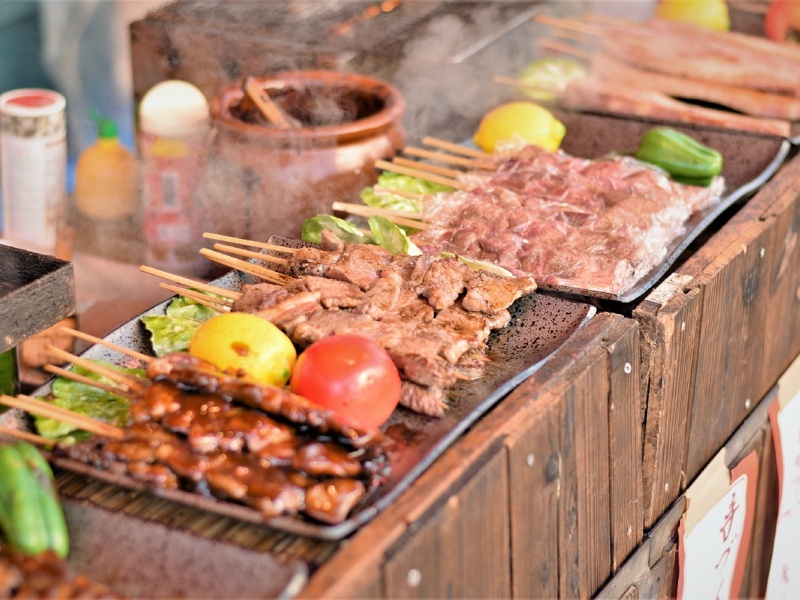
Charcoal grilled (yaki) meat skewers, particularly chicken (tori), are a typical street food in Japan as it is in parts of South East Asia.
Tasty in its most basic form, you can find different variations of Yakitori based on the cut of chicken meat used. Torikawa consists of crispy skin, Negima uses chicken thigh, and Tsukune is the meatball version of the dish.
In addition to being a street eat, you’ll readily find Yakitori at many izakayas, where they double as snacks to munch along with chilled beer.
Yakisoba
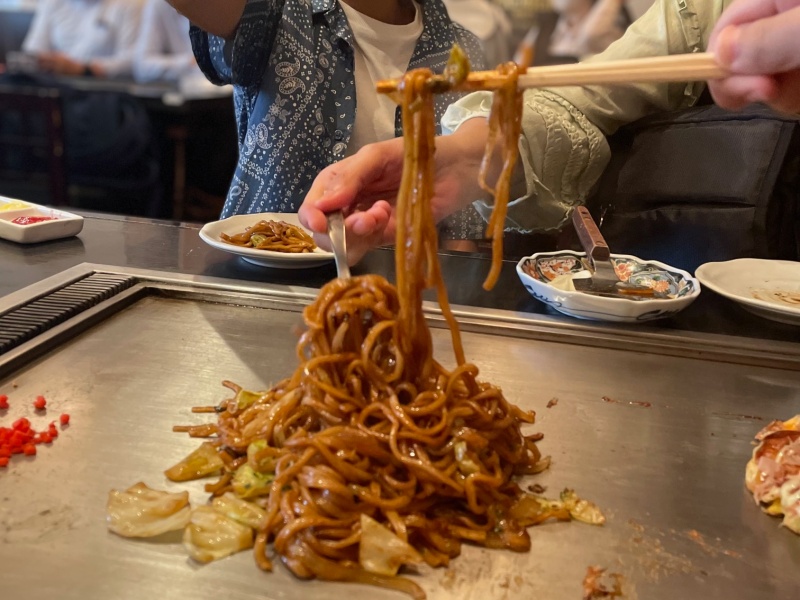
Yakisoba is Japan’s take on sautéed noodles, comparable to the Chinese chow mein. The dish includes boiled veggies (like cabbage, capsicum, bean sprouts, and shiitake mushrooms) and protein bits (pork or chicken) tossed with thin wheat noodles.
Yakisoba sauce includes soy and Worcestershire sauce, thus giving it a smoky and light-sweet flavor.
Once done, you can enjoy it with Japanese mayonnaise, seaweed powder, pickled ginger, or even a fried egg. A more innovative version is the Yakisoba pan, which is noodles inside a hotdog bun.
Yakisoba’s presence in Japan goes back to the 20th century. When rice was in shortage during WW2, it was a reliable and filling meal option.
Choco Bananas

Choco banana is a street-side dessert, usually available in summer festivals (matsuri). Made by dipping peeled and frozen bananas in melted chocolate, the snack gets a top coating of sprinkles, broken almonds or walnuts, granola, or crushed cookies.
To be more creative, some vendors mix food dye in white chocolate. It then helps create interesting characters like Doraemon and the minion on the banana.
Japan also has chocolate-banana-flavored cereal and kit-kats. Additionally, choco bananas have helped inspire the creation of the Tokyo Banana, a banana custard enveloped in a sponge cake.
Anmitsu
Imagine a parfait-like bowl with fruits and ice cream, and you’ll start to picture what Anmitsu looks like. It is a warm-weather dessert with translucent jelly-like cubes (agar), mochi rice cake pieces, sweet red bean paste (anko), and summer fruits like strawberries, peaches, and mandarin oranges.
Anmitsu comes alongside a pot of Mitsu syrup, including brown sugar and green tea extracts, for a distinct aroma and flavor. With so many condiments, it offers a myriad of velvety, creamy, and juicy textures.
The term ‘Anmitsu’ has a Buddhist connotation meaning ‘peace and tranquility,’ thus hinting at the contentment after its consumption. One can also top it with small rice dumplings and whipped cream.
Korokke
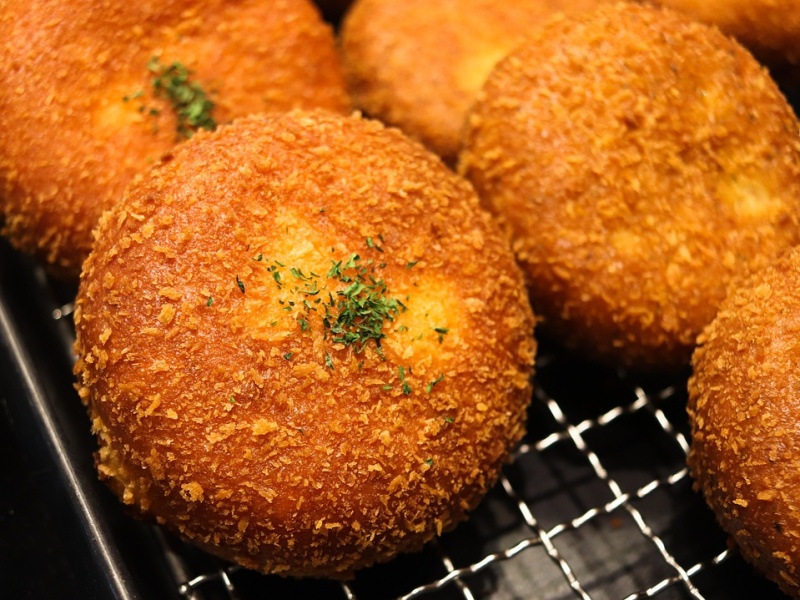
Korokke’s concept is similar to French Croquette or Dutch Kroket, only with regional ingredients added to the mix. A deep-fried patty with the filling of mashed potatoes and chopped meat, it has a top coating of panko breadcrumbs.
Served with sweet and tangy dips like Worcestershire and Tonkatsu sauces, Korokke has a golden-brown crispy texture with a mild starchy taste. One can also consume it as a side dish with miso soup or rice and use the leftovers to prepare a sandwich.
Korokke’s vegetarian version replaces meat with veggies like onions, carrots, corn, and peas. In the region of Hokkaido, the snack has a very moist texture due to the addition of white sauce and demi-glace sauce.
Natto

Natto is a nutrient-rich superfood and a breakfast staple in Japan, made by fermenting soybeans with bacteria. Its preparation takes more than 24 hours, resulting in a sticky dish with tiny strings covering the surface.
Usually, natto’s seasoning ingredients can depend on a person’s preference, with mustard and soy sauce being the standard options. You can consume it with a bowl of hot rice, stew, or as a sushi filling.
Our introduction to natto was primarily as a filling in a sushi roll that we picked up from the convenience store. The natto has a little bite to it, and its savory stickiness takes a little while to get used to.
Even though consumed across the country, it is more famous in the Kanto region. Mito, the capital of Ibaraki, also organizes the annual Natto festival and other contests.
Taiyaki
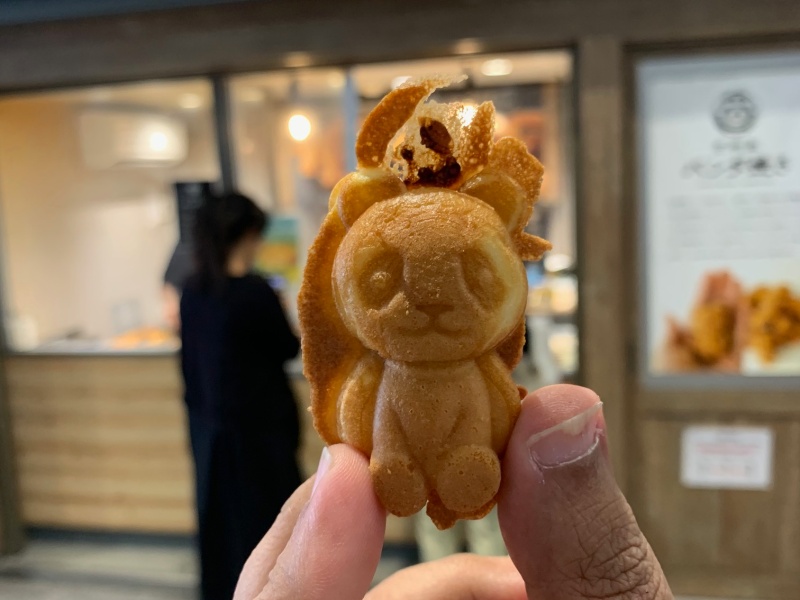
Taiyaki is what one might call Japan’s deceptive dessert. Even though it looks exactly like a fish, it contains no seafood whatsoever. The fish-shaped dessert, made in a unique mold, is like a closed pancake with red bean paste (anko) filling.
The final result is a crispy outer shell with a gooey and soft inside layer. You can also try Taiyaki with different fillings like Nutella, matcha, custard, and sweet potato to change things up a bit. Curry versions with sausages, cheese, and veggies are also available for people missing a sweet tooth.
Even though the snack enjoys nationwide popularity, it is a big hit in Tokyo’s Asakusa neighborhood. However, one thing that remains up for discussion is whether one should start eating the head or tail first.
Furthermore, you’ll find different versions of Taiyaki, like the miniature pandas we came across at a train station when heading to Ueno Zoo.
Kintsuba
Kintsuba is a popular Edo-region confection with a sweet bean paste filling and crispy dough shell. Shaped into small square pieces, the authentic snack usually consists of azuki paste with a fragile coating of wheat flour batter.
One can also try Kintsuba made with chestnut, matcha, sweet potato, sesame, or fruits for variations of this Japanese street food.
Kintsuba gets a slightly grainy and chewy texture because of its preparation process. The bean paste gives it a subtle earthy taste, thus making it a good option for consumption during tea ceremonies.
Kakigori
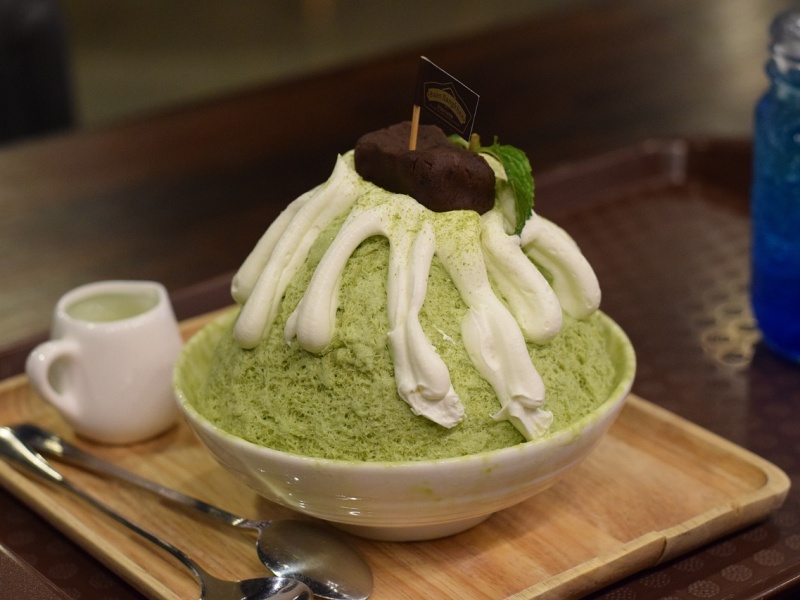
To beat the summer heat, Japanese natives usually prefer to cool down with a bowl of shaved ice dessert. Kakigori is a fluffy and soft ice clump with a drizzle of syrup on top. Strawberry, lemon, matcha, and melon are some available flavors.
Milk Kakigori is ideal for people craving something creamier. Additionally, you can select different toppings like condensed milk, sweet beans, or mochi.
Dating back thousands of years, Kakigori was initially a rich-class dessert. However, ice-making machines during the 19th century made it country-wide accessible. You’ll find all types of ice creams in Japan, but Kakigori can sometimes be hard to locate. So, if you come across this must-have Japanese street food, don’t leave trying it for later.
Pounding Mochi
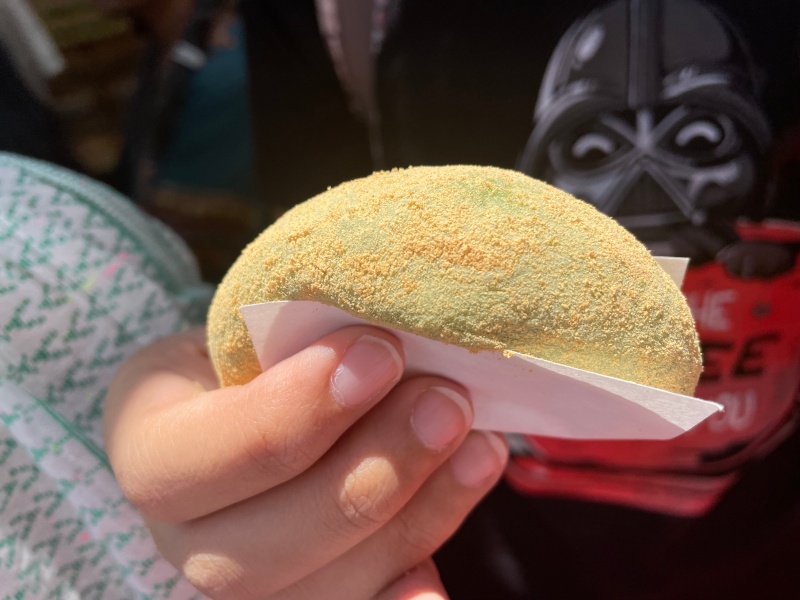
The fastest pounding mochi or mochitsuki is an award-winning mochi found only in Nara, which makes it a must-eat street food in Japan. The town famous for its shrines and bowing deer is also home to the Nakatanidou mochi shop, where artisans prepare the mochi by wetting it and simultaneously pounding it with large wooden hammers and by hand.
The result is yomogi mochi, a beautiful green and chewy ball of gelatinous rice, typically filled with red bean paste known as anko. Finally, they dust the mochi with roasted soybean flour.
The flavor is savorier, with the sweetness coming from the red beach paste. It is definitely an acquired taste, with everyone in the family, except for me, unsure if they would eat it again or not. I loved it!
Melon Pan
Melon Pan is a mildly sweet and crunchy dessert prepared after mixing two dough types. The top layer contains a certain amount of almond flour and has a generous granulated sugar coating. The remaining portion consists of a mixture of bread flour and eggs.
Given its cookie-like crust and inner pillowy texture, one might compare the snack to Mexican Conchas or Korean Soboro-pang. Melon Pan’s name comes from the dessert’s outer shell, with a cantaloupe-like grid pattern cut into it.
Even though the classic version doesn’t contain much flavor, some versions add a bit of melon cream or custard for a creamier taste. You can also find chocolate, matcha, or fruit-flavored Melon Pans. A popular street food in Japan, you’ll find melon pans easily across the country.
Karaage
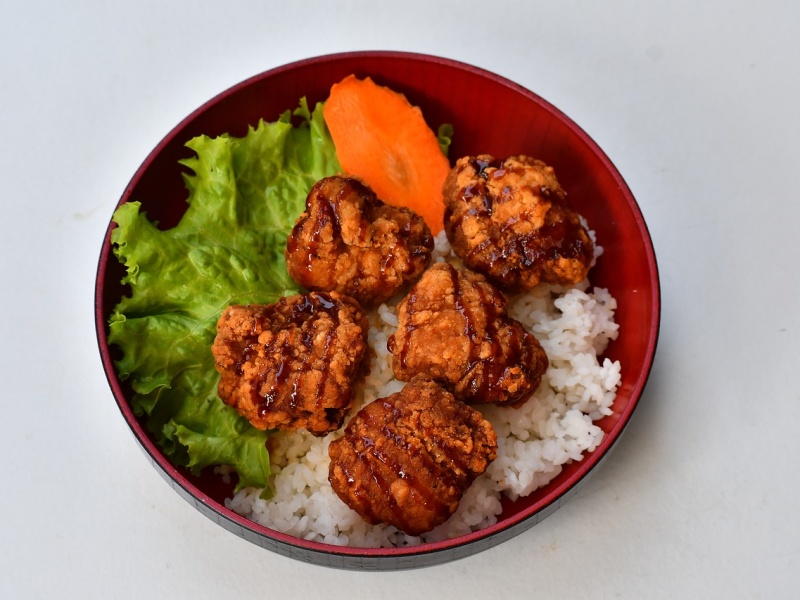
Karaage is a form of Japanese deep-fried chicken with an umami flavor and juicy texture. It contains bite-sized chicken pieces dipped in soy sauce, ginger, garlic, and sake (rice wine). While the sauce makes chicken savory and slightly salty, wine adds a dash of much-needed sweetness.
The preparation includes coating the meat bites with flour or starch batter and deep-frying till golden brown. Karaage’s balanced taste makes it ideal to consume with rice, shredded veggies, or mayonnaise.
Hokkaido’s Zangi is quite similar to Karaage, with the main difference being the addition of vinegar during the marination stage. Also, the outer batter coating tends to be thinner compared to Karaage.
Yatsuhashi
For tourists in Kyoto, Yatsuhashi is one of the souvenir options to take back home. The confectionery consists of mochi (glutinous rice flour), sugar, and cinnamon.
Yatsuhashi is available in two forms, baked or unbaked. The former has a cracker-like texture, while the latter tends to be more sticky and chewy. A red bean paste filling adds to the savory taste in some versions.
Yatsuhashi has a distinct triangle shape with a bit of an arch in the center. Some locals say the snack is a tribute to an Edo-era blind harp player, as the shape is somewhat like that of a harp. Others connect it to a scenic location in Kyoto.
Yaki Tomorokoshi
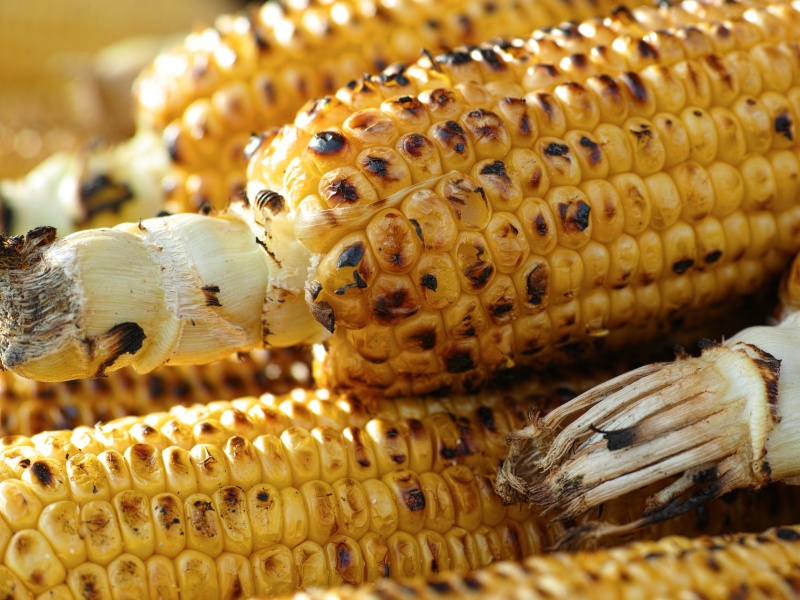
Yaki Tomorokoshi is the classic corn-on-a-cob with a Japanese twist. It gets its enhanced caramelized flavor due to a light butter, soy sauce, or miso coating.
The preparation process includes pulling back the husk, soaking corn in salt water, boiling it for a little while, then grilling it over an open flame. The end product has a slightly smoky charcoal aroma while maintaining the juiciness of the kernels.
One can also add mayonnaise, garlic powder, and chili powder to make the cob creamier and tangier. Usually associated with the Tohoku region, Tomorokoshi is an essential part of summer festivals and is available all over Japan.
Convenience Store Treats
If you’re looking for street food in Japan, convenience stores are a great place to start. The big three brands – 7-Eleven, Lawson, and Family Mart – offer a wide range of quick eats you can enjoy on the go or while waiting for your train. While there are some everyday items across all three brands, each store has a unique selection.
One of the most popular convenience store snacks is Onigiri, rice triangles/circles/balls wrapped in nori and filled with various ingredients like tuna, pickled plum, boiled kelp, and salmon.
You can also find freshly made bread buns in stores, which you can use to create a sandwich by pairing it with freshly baked or fried products like chicken and ham cutlets available near the counter. Then there are a bunch of sandwiches, including the must-have Tomago Sando (Japanese Egg Sandwiches).
Additionally, you’ll find salads, bento boxes, and meals with noodles or meat. Don’t forget to check out the various types of chips too! They have flavors like clam, Spam, shrimp, wasabi, and chicken ramen.
Cup Noodles
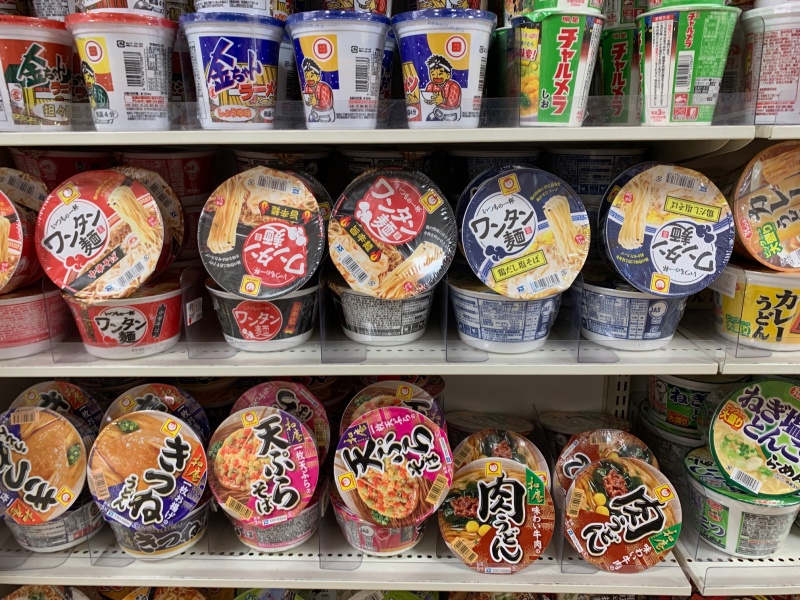
Cup Noodles from convenience stores and supermarkets are another excellent street food option, convenient to eat and readily available. The variety of choices you get in Japanese Cup Noodles is quite honestly mind-boggling, to the extent that it can easily take 5-10 minutes to decide which flavor you want.
In many larger convenience stores, you can ask the staff for hot water, or there are vending machines to cook the noodles. Although Cup Noodles are perfect for when you want to eat on the go, we found having a few cups in the hotel room to be very beneficial.
Since they are delicious and easy to make, Cup Noodles are the perfect light meal for when the kids suddenly feel peckish, or one of us wants a late-night snack.
And if, like us, you are crazy about Cup Noodles, don’t forget to visit the Cup Noodles Museum, one of the must-visit places in Osaka for kids, to make a bespoke cup.
Boba Tea
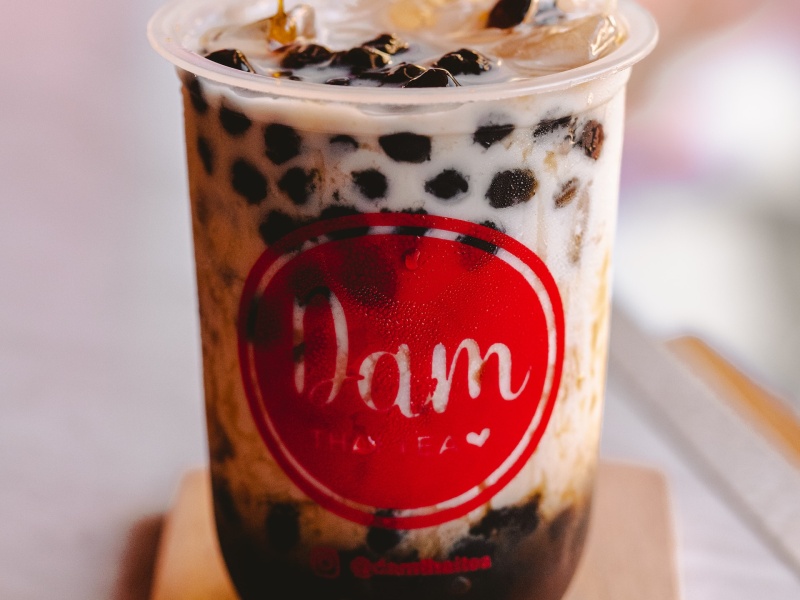
Boba tea might not be exclusive to Japan. Still, it is relatively popular in trendy cafes and neighborhoods like Harajuku and Shibuya, where you’ll find several boba tea shops.
Of course, as with other drinks in Japan, you’ll find unique flavors such as matcha, melon, brown sugar, mango, rock salt cheese tea, fruit teas with coconut jelly, and so much more.






11 Comments